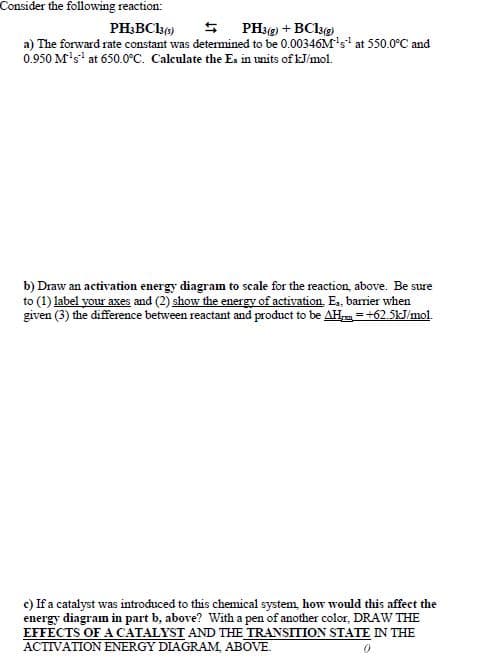Consider the following reaction: PH;BCko) 5 PH3e) + BCle) a) The forward rate constant was determined to be 0.00346M's' at 550.0°C and 0.950 M's' at 650.o°C. Calculate the Ea in units of kJ/mol. b) Draw an activation energy diagram to scale for the reaction, above. Be sure to (1) label your axes and (2) show the energy of activation. Es, barrier when given (3) the difference between reactant and product to be AH,=+62.5kJ/mol.
Consider the following reaction: PH;BCko) 5 PH3e) + BCle) a) The forward rate constant was determined to be 0.00346M's' at 550.0°C and 0.950 M's' at 650.o°C. Calculate the Ea in units of kJ/mol. b) Draw an activation energy diagram to scale for the reaction, above. Be sure to (1) label your axes and (2) show the energy of activation. Es, barrier when given (3) the difference between reactant and product to be AH,=+62.5kJ/mol.
Chemistry: Principles and Reactions
8th Edition
ISBN:9781305079373
Author:William L. Masterton, Cecile N. Hurley
Publisher:William L. Masterton, Cecile N. Hurley
Chapter11: Rate Of Reaction
Section: Chapter Questions
Problem 96QAP: Consider the following energy diagram (not to scale) for the reaction. 2CH3(g)C2H6(g) (a) What is...
Related questions
Question
Answer all questions attached (3 parts for 1 questions)

Transcribed Image Text:Consider the following reaction:
PH;BCko)
5 PH3e) + BCke)
a) The forward rate constant was determined to be 0.00346M's' at 550.0°C and
0.950 M's' at 650.o°C. Calculate the Ea in units of kJ/mol.
b) Draw an activation energy diagram to scale for the reaction, above. Be sure
to (1) label your axes and (2) show the energy of activation Es, barrier when
given (3) the difference between reactant and product to be AH,=+62.5kJ/mol.
c) If a catalyst was introduced to this chemical system, how would this affect the
energy diagram in part b, above? With a pen of another color, DRAW THE
EFFECTS OF A CATALYST AND THE TRANSITION STATE IN THE
ACTIVATION ENERGY DIAGRAM, ABOVE.
Expert Solution
This question has been solved!
Explore an expertly crafted, step-by-step solution for a thorough understanding of key concepts.
This is a popular solution!
Trending now
This is a popular solution!
Step by step
Solved in 2 steps with 2 images

Knowledge Booster
Learn more about
Need a deep-dive on the concept behind this application? Look no further. Learn more about this topic, chemistry and related others by exploring similar questions and additional content below.Recommended textbooks for you

Chemistry: Principles and Reactions
Chemistry
ISBN:
9781305079373
Author:
William L. Masterton, Cecile N. Hurley
Publisher:
Cengage Learning

Introductory Chemistry: A Foundation
Chemistry
ISBN:
9781337399425
Author:
Steven S. Zumdahl, Donald J. DeCoste
Publisher:
Cengage Learning

Chemistry: The Molecular Science
Chemistry
ISBN:
9781285199047
Author:
John W. Moore, Conrad L. Stanitski
Publisher:
Cengage Learning

Chemistry: Principles and Reactions
Chemistry
ISBN:
9781305079373
Author:
William L. Masterton, Cecile N. Hurley
Publisher:
Cengage Learning

Introductory Chemistry: A Foundation
Chemistry
ISBN:
9781337399425
Author:
Steven S. Zumdahl, Donald J. DeCoste
Publisher:
Cengage Learning

Chemistry: The Molecular Science
Chemistry
ISBN:
9781285199047
Author:
John W. Moore, Conrad L. Stanitski
Publisher:
Cengage Learning

Chemistry for Engineering Students
Chemistry
ISBN:
9781337398909
Author:
Lawrence S. Brown, Tom Holme
Publisher:
Cengage Learning

Chemistry for Engineering Students
Chemistry
ISBN:
9781285199023
Author:
Lawrence S. Brown, Tom Holme
Publisher:
Cengage Learning

Chemistry: An Atoms First Approach
Chemistry
ISBN:
9781305079243
Author:
Steven S. Zumdahl, Susan A. Zumdahl
Publisher:
Cengage Learning